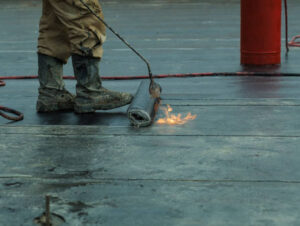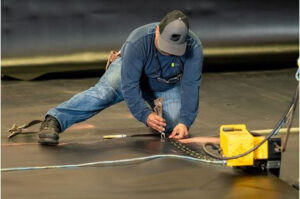Geomembrane welding refers to the connection of two or more geomembranes by thermal welding to form a continuous and airtight seam.
This ensures that the geomembrane is completely sealed during application and provides effective anti-penetration and anti-leakage properties.
Geomembrane welding usually uses hot melt welding technology.

Five steps for geomembrane welding
Preparation: Unfold the geomembrane to be welded and make sure the surface is clean, dry and smooth. At the same time, prepare the welding machine, heat gun, welding nozzle and welding auxiliary tools.
Alignment and clamping: Align the edges of the geomembrane to be welded, and use a jig or weight to clamp to ensure a certain degree of overlap between the two geomembranes.
Preheating: Use a heat gun to preheat the area to be welded. The preheating temperature and time should be determined according to the type and thickness of the geomembrane material. The purpose of preheating is to soften the geomembrane, making it easier to melt and fuse during welding.
Welding: On the preheated geomembrane surface, a welding machine and welding nozzle is used to place hot melt material (usually the same type of geomembrane) at the seam. By applying high temperature and pressure, the hot melt material melts and fuses with the geomembrane surface to form a strong welded joint.
Welding inspection: After welding is completed, the welded joints need to be inspected to ensure welding quality and tightness. Verification may be by visual inspection, tensile testing or other testing methods.
It is worth noting that the operation of geomembrane welding must be performed by professionals who have received special training and are familiar with welding technology. Incorrect welding practices can lead to problems such as joint weakening, leakage, or structural damage to the welded area.
Therefore, before proceeding with welding operations, please ensure that you strictly follow the relevant welding operation specifications and recommendations, and follow the manufacturer’s instructions and recommendations.

Several things to pay attention to when welding geomembrane
Outdoor environment: Ensure that the welding operation is carried out in a suitable outdoor environment to avoid adverse weather conditions affecting the welding effect. Avoid welding operations under adverse conditions such as strong wind, rainfall or high temperature.
Geomembrane material: Use the same type and specification of geomembrane for welding to ensure the quality and performance of the welded joint. Geomembranes of different materials may not be easily fused together or the fusion effect is not ideal during the thermal fusion process.
Clean the surface: Before welding, make sure the surface of the geomembrane is clean and free of dust, oil and other contaminants. Clean the surface of the geomembrane with detergent or water and make sure it is completely dry. Clean surfaces contribute to the quality and durability of welded joints.
Welding pressure and temperature: According to the requirements and specifications of geomembrane materials, set the appropriate welding pressure and temperature. Excessively high or low welding pressure and temperature will affect the welding effect, which may lead to substandard welding seam quality or damage to the welding area.
Welding speed: During the welding process, maintain an appropriate welding speed and pay attention to the smooth movement of the welding head. Excessive welding speed may result in insufficiently fused seams or weak seams.
Welding inspection: After welding is completed, the welded joints are inspected. Perform a visual inspection to ensure an even and complete seal of the welded seam. Tensile testing or other testing methods may be performed to verify the quality and strength of the weld.
Training and Experience: Geomembrane welding is a specialized technique and requires trained and experienced operators. Make sure welding operations are performed by professionals to ensure the quality and reliability of welded joints.
Author

Founded in 2002, Tinhy's team focuses on the manufacturing, marketing, installation, application and research and development of geosynthetic materials.
View all posts





